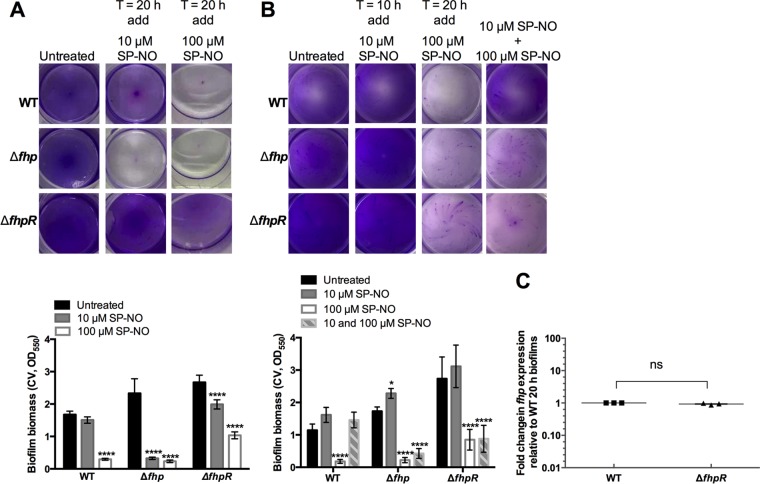FIG 6.
(A) The Δfhp mutant strain is more sensitive to NO-mediated induction of dispersal than the wild-type strain and the ΔfhpR mutant in 20-h biofilms. Biofilms of P. aeruginosa WT and the Δfhp and ΔfhpR transposon mutant strains grown in multiwell plate batch cultures at room temperature for 20 h were treated with 10 μM or 100 μM SP-NO for 15 min before CV staining. Experimental details are shown in Fig. S1B in the supplemental material. The error bars indicate standard deviations (n = 3). The asterisks indicate statistically significant differences compared to untreated control samples (****, P < 0.0001). Each image represents the stained biofilms. (B) Δfhp and ΔfhpR mutant strains still retain their dispersal capacity after pretreatment with an initial low dose of NO in the 20-h biofilm system. Biofilms of P. aeruginosa WT and Δfhp and ΔfhpR transposon mutant strains were grown in multiwell plate batch cultures for a total of 20 h 15 min, including or not a pretreatment with 10 μM SP-NO at t = 10 h and a dispersal treatment with 100 μM SP-NO at t = 20 h. At the end of the incubation, the biofilm biomass was analyzed by CV staining. Experimental details are shown in Fig. S1C in the supplemental material. The error bars indicate standard deviations (n = 3). The asterisks indicate statistically significant differences compared to untreated control samples (*, P < 0.1; ****, P < 0.0001). Each image represents the stained biofilms. (C) No significant differences were found in fhp mRNA levels between 20-h biofilms formed by P. aeruginosa wild type and the ΔfhpR mutant. The error bars indicate standard errors (n = 3). ns, no significant difference.

